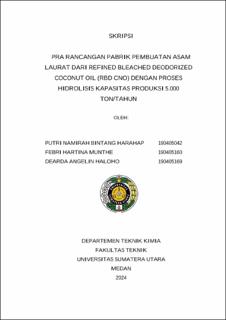Pra Rancangan Pabrik Pembuatan Asam Laurat dari Refined Bleached Deodorized Coconut Oil (RBD CNO) dengan Proses Hidrolisis Kapasitas Produksi 5.000 Ton/Tahun
Preliminary Plant Design of Lauric Acid from Refined Bleached Deodorized Coconut Oil (RBD CNO) with Hydrolysis Process Production Capacity 5.000 Tons/Year

Date
2024Author
Harahap, Putri Namirah Bintang
Munthe, Febri Hartina
Haloho, Dearda Angelin
Advisor(s)
Maulina, Seri
Dalimunthe, Nisaul Fadilah
Metadata
Show full item recordAbstract
Lauric acid is a saturated fatty acid with a 12-carbon chain. Lauric acid is widely
used in the cosmetics industry as a moisturizer and softener, as a raw material for
surfactants, food coatings, pharmaceuticals, and in the soap and shampoo
industries. One of the most abundant sources of fatty acids is coconut oil. Coconut
oil needs processing to improve its quality through degumming, bleaching, and
deodorizing processes to produce a product known as RBD CNO (Refined Bleached
Deodorized Coconut Oil). Indonesia is one of the largest coconut producers in the
world, but the demand for lauric acid in Indonesia still relies on imports. Therefore,
it is necessary to establish a plant to meet domestic lauric acid needs. The predesign
of the lauric acid plant from refined bleached deodorized coconut oil (RBD
CNO) with a hydrolysis process has a production capacity of 5,000 tons/year. The
main process in this plant pre-design consists of two stages namely the reaction
(hydrolysis) stage and the product purification stage. This plant is planned to be
established in Belawan Bahari Village, Medan Belawan District, Medan City,
North Sumatra, with a land area of 23,170 m², 141 workers are needed, and the
business entity will be in the form of a limited liability company (PT) led by a chief
director with a line and staff organizational system. The establishment and
operation of the plant require an investment capital of IDR 551.953.963.614,36 and
production costs of IDR 387.026.370.276,57. Based on economic analysis, this
plant has a Profit Margin (PM) of 26.54%, Break-Even Point (BEP) of 48.52%,
Return on Investment (ROI) of 18.20%, Return on Net Worth (RON) of 30.34%,
Payback Period (POT) of 5.5 years, and Internal Rate of Return (IRR) of 19.91%.
From the results of the economic analysis, it can be concluded that this plant is
feasible to establish.
Collections
- Undergraduate Theses [1239]
